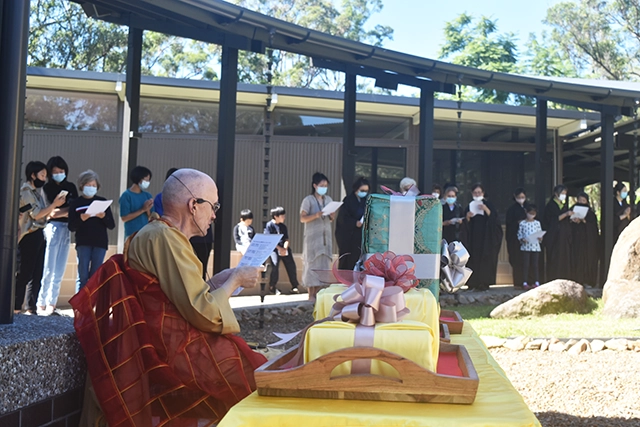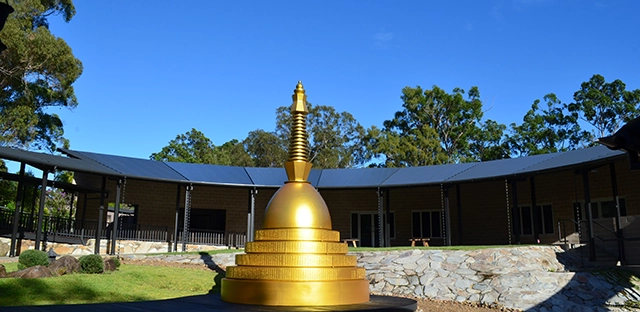澳洲金岸法界提供 呂明賜 英譯 VBS 624
By Gold Coast Dharma Realm in Australia English translated by Michael Lu
2022年農曆三月十六日(西曆4月16日),準提菩薩的聖誕, 亦是宣公上人的聖誕。藉此吉日,澳洲金岸法界舉行宣公上人誕辰紀念法會,恭迎上人舍利於新落成的金剛舍利寶塔內供奉。
On the auspicious day of April 16, 2022(sixteenth day of the third lunar month), Cundī Bodhisattva’s and Venerable Master Hsuan Hua’s birthday, Australia’s Gold Coast Dharma Realm held a commemoration in honor of the Venerable Master’s birthday and respectfully transferred his sharira into the newly-built Jeweled Vajra Sharira Stupa.
是日,殊勝吉祥,陽光明媚,金岸法界楞嚴聖寺大殿內舉行禮塔法會,恒實法師主法,帶領大眾依照禮塔儀軌如法拜懺。之後四眾弟子排班出列,稱念佛號及宣公上人名號,至中央花園金剛舍利寶塔處,右行繞塔兩列站立。由恆實法師於金剛塔前捻香禮佛,向大眾開示繞塔和瞻禮舍利的意義。然後在莊嚴的誦咒聲中,將宣公上人舍利恭迎入塔內供奉。一併入塔裝藏的還有三大部大乘經典及佛教七寶。
It was a bright and sunny day, splendid and auspicious, as the Dharma Assembly for Bowing to the Stupa was held within the Main Hall of Gold Coast Dharma Realm’s Shurangama Sagely Monastery. Reverend Heng Sure was the Dharma host and guided the assembly in bowing a repentance according to the procedures for bowing to a stupa. Afterwards, while reciting the Buddha’s and Venerable Master Hua’s name, everyone (fourfold assembly) lined up and walked outside to the Jeweled Vajra Sharira Stupa in the central garden. They then circumambulated the stupa clockwise and formed two lines. Reverend Heng Sure offered incense and bowed in front of the Vajra Stupa, and proceeded to explain to the assembly the meaning behind circumambulating the stupa and venerating sharira. Amidst the solemn chanting of mantras, Venerable Master Hua’s sharira was respectfully transferred into the stupa. The three major Mahayana sutras as well as the seven jewels of Buddhism were also placed in the stupa for veneration.
塔,是佛教的象徵,起源於印度,梵文為Stupa,意為高顯之處,用於供奉舍利。在公元一世紀佛教傳入中國時,漢字裡並沒有「塔」這個字,而是採用「浮屠」,「窣堵波」等音譯,如「救人一命,勝造七級浮屠」等。直到東漢後期,翻譯家才創作出新的漢字「塔」,編入《說文解字》,作為統一的譯名,沿用至今。塔是佛教建築中重要的組成部分。古印度的佛寺,以及中國隋唐時期的佛寺,都是以塔為中心的。The stupa is a Buddhist symbol that originated from India. The name is Sanskrit and means “an elevated place,” which is used to house sharira. During the first st century CE, when Buddhism first came to China, the Chinese language did not have the character “tǎ 塔” for stupa, instead relying on various transliterations (e.g. “fu tu 浮屠” and “su du bo 窣堵波”), such as in the saying, “Saving a person’s life surpasses building a seven-storied stupa.” Only until the second half of Later Han Dynasty did translators coin the new character “tǎ 塔,” which was then added to Shuo Wen Jie Zi (説文解字), an analytical dictionary of Chinese characters, and standardized, and which has continued to be used up to the present. The stupa plays a significant role in Buddhist architecture. Buddhist monasteries in ancient India as well as during the Sui and Tang dynasties in China centered around the stupa.
為什麼要建塔?根據《法苑珠林》的記載有三意:1,表人勝—意為德高望重;2,令他信——使人見塔生信;3,報佛恩—報得佛及師長之恩。
Why is there a need to build stupas? According to a Buddhist encyclopedia, there are three purposes: first is to signify the eminent virtue and reputation of the people present; second is to inspire faith in those who see the stupa; and third is to repay the kindness of the Buddha as well as teachers and elders.
智者大師認為塔是「實相之境,法身所依處也」。南傳《根本律釋》云:「佛塔即法身。」北傳《寶積經》云:「何人供養承事住世之我與涅槃後之佛塔,其二功德相等。何以故?因佛陀以法身而立,非以色身而立。」提到佛塔最多的經典莫過於《妙法蓮華經》了,有十七品共78次提到「塔」,著名的偈頌如
Great Master Zhizhě 智者 interpreted the stupa as the “state of ultimate reality and the refuge for the Dharma body.” The Theravadan Mūlasarvāstivāda-Vinaya states, “The stupa for the Buddha is his Dharma body.” The Mahayana Ratnakūṭa Sutra says, “One who makes offerings and serves me while I’m in the world and one who makes offerings to my stupa after I enter nirvana have identical merit and virtue. Why? The Buddha is characterized by his Dharma body, not by his physical body.” No sutra mentions stupas more than the Wonderful Dharma Lotus Sutra, with seventy-eight occurrences of the word “stupa” across seventeen chapters. Many famous verses have come from this text, including:
乃至童子戲,
聚沙為佛塔,
如是諸人等,
皆已成佛道。
Or even children who, at play,
Heaped up sand to make a stupa.
People such as these
Have all realized Buddhahood.

即是出自於此。「誰建浮圖禮大千,靈光遙與白雲連。」歷代高僧多有禮塔的記載,清代的武昌寶通寺「摸腦和尚」,手到病除,他的修行方法就是每天繞塔默誦〈大悲咒〉。又如近代的金山活佛,於緬甸仰光禮大金塔的苦行傳頌至今。
“Who built this stupa for people to bow to the large world system? Its divine light joins with the distant white clouds.” Many eminent monks of the past have records of bowing to stupas. For example, the “Head-Scratching Monk” from Baotong Monastery in Wuchang during the Qing Dynasty, who was known for curing illnesses with his hands, maintained the daily practice of circumambulating a stupa while reciting the Great Compassion Mantra. The contemporary “Living Buddha of Gold Mountain” also famously made a hardship-filled pilgrimage to Yangon, Myanmar to bow to the Great Dagon Pagoda.
佛塔的樣式多種多樣,因地制宜,但是基本樣式都是由塔基,塔身和塔剎所組成的。金岸法界金剛舍利塔的制式以古印度形製為主,並參考各處佛塔樣式而設計出的具有澳洲特色的寶塔。金岸法界佛塔屬於覆缽式銅質寶塔,塔勢如從地湧出,自下向上分別由須彌圓座和四層金剛圈構成基座、採用覆缽丘形制的塔身、十三層相輪及寶珠剎所構成的塔剎三部分所構成。通體金色,並於四層金剛圈外圍陽刻《金剛般若波羅蜜經》全文。因寶塔外刻金剛經,內供舍利子,故稱金剛舍利寶塔。在澳洲湛藍的天空背景下,陽光把金塔照得熠熠生輝,可謂水搖金剎影,日動火珠光。
Buddhist stupas come in many different shapes and styles. They vary based on local customs, but generally consist of a base, a body, and a finial. The Jeweled Vajra Sharira Stupa at Gold Coast Dharma Realm was modeled after its ancient Indian counterpart but also has distinctively Australian features, which were crafted after studying various stupa styles around the globe. The stupa is made of bronze and shaped like an inverted bowl, thus giving the impression that it welled up from below the earth. From the bottom up, it has a base that consists of a circular Sumeru seat and four concentric vajra rings, a mound-like body in the shape of an inverted bowl, and a finial of thirteen wheel-like rings and a precious pearl. The entire structure is golden, and the Vajra Prajna Paramita Sutra is carved along the four concentric vajra rings. Since the Vajra Sutra is carved on the outside of the stupa and sharira are housed inside, it bears the name Jeweled Vajra Sharira Stupa. With the blue skies of Australia in the background, the golden stupa shimmers in the sunlight. As the poem goes:
The golden stupa’s reflection quivers in the water;
The sun shines bright as a blazing pearl.
佛塔是用來供奉舍利的,而只有得道的聖人才有舍利。據《金光明經·捨身品》論述:「是舍利者,即是無量六波羅蜜多功德所熏」。「舍利是戒定慧所熏修,甚難可得,最上福田。」
Buddhist stupas house sharira, which come only from sages who have realized awakening. “The Chapter on Renouncing One’s Body” of the Sutra of Golden Light says: “Sharira are smelted by the merit and virtue from limitless practice of the Six Paramitas” and “Sharira are smelted by one’s practice of precepts, samadhi, and wisdom. They are extremely difficult to obtain and are the foremost fields of blessings.”
澳洲黃金海岸福地重元,有著宣公上人真身舍利的庇護。而能在上人誕辰的這一天迎請上人舍利入塔供奉,更有著特殊的意義。
Australia’s Gold Coast is a place of blessings and prosperity since it is protected by the Venerable Master’s sharira. Being able to transfer the Venerable Master’s sharira into the new stupa on his birthday adds yet another layer of meaning to the special occasion.
恒實法師在舍利入塔的開示中說,今日宣公上人的舍利子被供奉在澳洲金岸法界楞嚴聖寺的金剛舍利塔內,應該說對黃金海岸,對昆士蘭州,澳大利亞乃至全世界都是殊勝吉祥的一件事情。恒實法師解説繞塔禮舍利的修行法門,鼓勵大家多來金岸法界「繞塔禮佛,當願眾生,所行無逆,成一切智。」
During the instructional talk given while the sharira was being transferred into the stupa, Reverend Heng Sure said that the day’s proceedings of housing the Venerable Master Hua’s sharira in the Vajra Sharira Stupa of Gold Coast Dharma Realm’s Shurangama Sagely Monastery was a splendid and auspicious event for the Gold Coast, the state of Queensland, the country of Australia, as well as the entire world. Reverend Heng Sure explained the Dharma practice of circumambulating stupas and bowing to sharira and encouraged everyone to practice it by coming often to Gold Coast Dharma Realm.
When circumambulating and bowing to stupas,
I vow that all living beings
Will do nothing that goes against the Way
And realize omniscient wisdom. ♦
